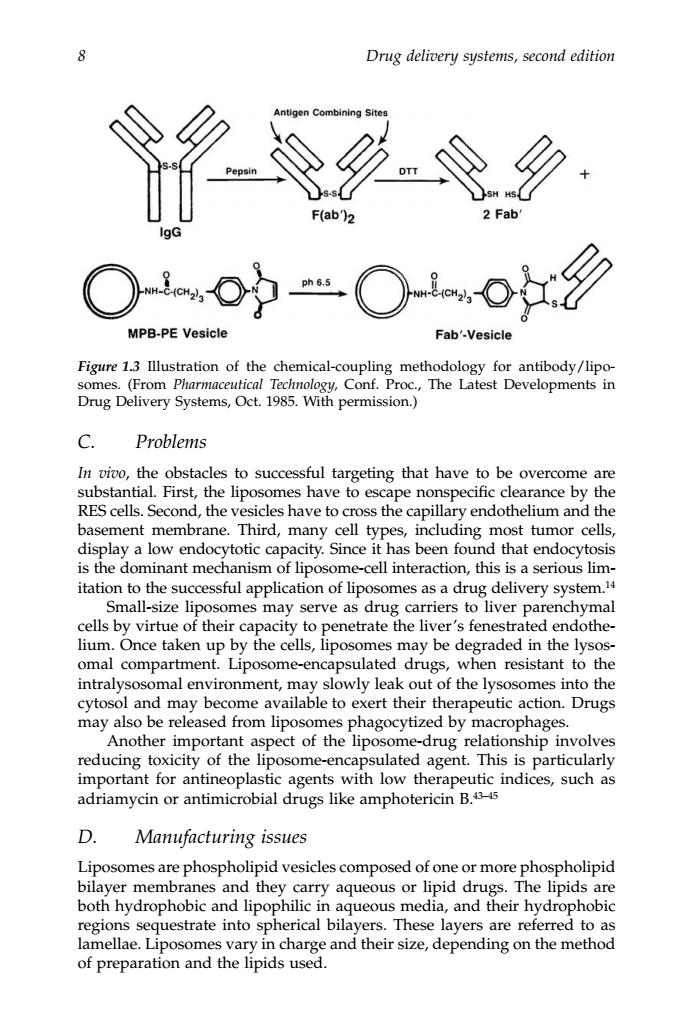正在加载图片...

Drug delivery systems,second edition D-O&≥ F(ab -PE V Fab'-Vesicle re13 lustration of the chemical-coupng methodologyforniy The La atest Dev lopments C.Problems In,the obstacles to successful targeting that have to be overcome are substant ial.First,the liposomes have to escape nonspecific earance by the RES cells.Second,the vesicles have to cross the capillary endothelium and the basement membrane.Third,many cell types,including most tumor cells, display a low endocytotic capacity.Since it has been found that endocytosis is the dominant mechanism of liposome-cell interaction,this is a serious lim- itation to the delivery system. cells by virtue of their capacity to penetrate the liver's fenestrated endothe- lium.Once taken up by the cells,liposomes may be degraded in the lysos- omal compartment.Liposome-encapsulated drugs,when resistant to the intralysosomal environment,may slowly leak out of the lysosomes into the cytos and ma y be come available to exert their therapeutic c action.Drugs may also be released from liposomes phagocytized by macrophages. Another important aspect of the liposome-drug relationship involves reducing toxicity of the liposome-encapsulated agent.This is particularly important for antineoplastic agents with low therapeutic indices,such as adriamycin or antimicrobial drugs like amphotericin B.-45 D Manufacturing issues Liposomes are phospholipid vesicles composed of one or more phospholipid bilaver membranes and they carry aqueous or lipid lipids ard both hydrophobic and lipop hilic in aqueous d regions sequestrate into spherical bilayers.These layers are referred to as lamellae.Liposomes vary in charge and their size,depending on the method of preparation and the lipids used. 8 Drug delivery systems, second edition C. Problems In vivo, the obstacles to successful targeting that have to be overcome are substantial. First, the liposomes have to escape nonspecific clearance by the RES cells. Second, the vesicles have to cross the capillary endothelium and the basement membrane. Third, many cell types, including most tumor cells, display a low endocytotic capacity. Since it has been found that endocytosis is the dominant mechanism of liposome-cell interaction, this is a serious limitation to the successful application of liposomes as a drug delivery system.14 Small-size liposomes may serve as drug carriers to liver parenchymal cells by virtue of their capacity to penetrate the liver’s fenestrated endothelium. Once taken up by the cells, liposomes may be degraded in the lysosomal compartment. Liposome-encapsulated drugs, when resistant to the intralysosomal environment, may slowly leak out of the lysosomes into the cytosol and may become available to exert their therapeutic action. Drugs may also be released from liposomes phagocytized by macrophages. Another important aspect of the liposome-drug relationship involves reducing toxicity of the liposome-encapsulated agent. This is particularly important for antineoplastic agents with low therapeutic indices, such as adriamycin or antimicrobial drugs like amphotericin B.43–45 D. Manufacturing issues Liposomes are phospholipid vesicles composed of one or more phospholipid bilayer membranes and they carry aqueous or lipid drugs. The lipids are both hydrophobic and lipophilic in aqueous media, and their hydrophobic regions sequestrate into spherical bilayers. These layers are referred to as lamellae. Liposomes vary in charge and their size, depending on the method of preparation and the lipids used. Figure 1.3 Illustration of the chemical-coupling methodology for antibody/liposomes. (From Pharmaceutical Technology, Conf. Proc., The Latest Developments in Drug Delivery Systems, Oct. 1985. With permission.)